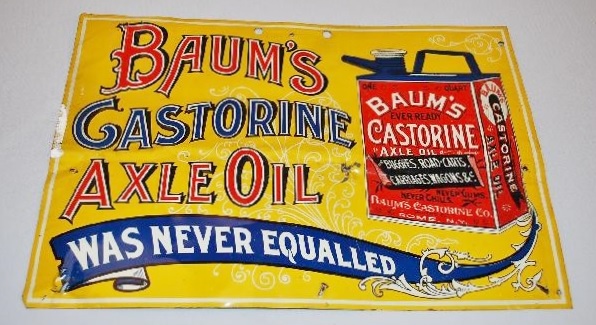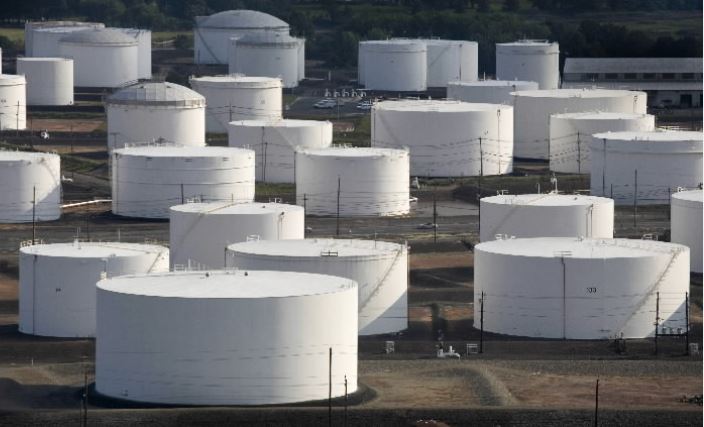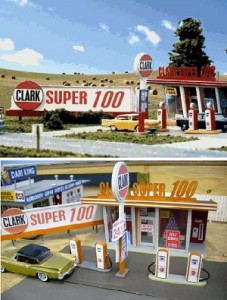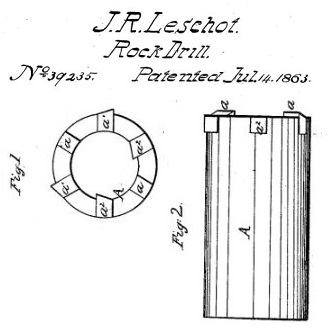July 8, 1848 – Congress charters Gas Light Company –
Four days after the laying of the Washington Monument cornerstone, an Act of Congress established the Washington Gas Light Company, which manufactured “town gas” for lighting and heat. The new utility constructed giant tanks (gasometers) on 6.5 acres of gasworks in the D.C. neighborhood of Foggy Bottom.

Washington Monument view of manufactured gas works and gasometer tank at Foggy Bottom in Northwest D.C. Photo courtesy Washington Gas Light Company, operating 175 years in 2023.
The public clamored for gas lighting like that already available in Baltimore and Philadelphia (see Illuminating Gaslight), and after multiple unsuccessful petitions to Congress, the utility received its charter, according to local historian Kent Mountford. George Riggs and William Corcoran played significant roles in the company, which supplied the Capitol building with the illuminating gas.
Natural gas service to the D.C. region began in 1931 — when President Herbert Hoover opened a pipeline valve to start the flow from natural gas fields in Kentucky and West Virginia. WGL celebrated its 175th anniversary in 2023.
July 8, 1937 – War Secretary approves Drilling Pier Experiment
Secretary of War Harry Woodring approved an ambitious engineering plan to build a Gulf of Mexico pier one mile long to search for oilfields in offshore salt dome formations. Woodring approved exploratory wells by the Humble Oil and Refining Company near McFaddin Beach at Port Author, Texas. The company built an experimental pier on a 60-acre lease eight miles east of High Island in Galveston County and drilled using three rigs, but found no oil. A hurricane destroyed the pier in 1938.
Learn more by visiting the Galveston Bay offshore rig museum Ocean Star.
July 9, 1815 – West Virginia Natural Gas Discovery
Natural gas was discovered accidentally by Capt. James Wilson while digging a brine well within the present city limits of Charleston, West Virginia (Virginia in 1815). Earlier, a young surveyor — George Washington — had written about “burning springs” and petroleum seeps northward, along the Kanawha River.
Awarded a land grant for his service in the French and Indian War, Washington acquired 250 acres along the river. He later explained choosing the location, “on account of a bituminous spring which it contains, of so inflammable a nature that it burns as freely as spirits.”
In his 1994 history of West Virginia’s oil industry, David L. McKain concluded, “This was in 1771, making the father of our country the first petroleum industry speculator.”
July 9, 1883 – Finding Oil in the Land of Oz
The future author of the children’s novel The Wonderful Wizard of Oz operated a business selling petroleum products in Syracuse, New York. The store offered lubricants, oils, greases — and “Baum’s Castorine, the Great Axle Oil.”

L. Frank Baum’s many “Castorine” oil sales trips may have led to his idea of a Tin Woodman character with an oil can.
L. Frank Baum — whose father had found success in Pennsylvania oilfields — served as chief salesman for Baum’s Castorine Company, which operates today in Rome, New York. Reporting on the opening, the Syracuse Daily Courier newspaper said Baum’s Castorine was a rust-resistant axle grease concoction for machinery, buggies, and wagons. The axle grease was advertised to be “so smooth it makes the horses laugh.”

L. Frank Baum and his brother Benjamin in 1883 launched their successful business venture offering lubricants, oils, greases, and “Baum’s Castorine, the great axle oil.”
Although Baum sold the Castorine business in 1900, an Oz historian researched company records in Rome, New York, and found the idea for the Tin Man character began with Baum’s oil.
Learn more in Oil in the Land of Oz.
July 10, 2000 – DOE establishes Home Heating Oil Reserve
President Bill Clinton directed Energy Secretary Bill Richardson to establish the Northeast Home Heating Oil Reserve (NEHHOR) for use during severe winters and other supply emergencies. The reserve of 2 million barrels was expected to last 10 days, the time required for tankers to bring more heating oil from the Gulf of Mexico to New York Harbor.

One million barrels of NEHHOR oil are stored in commercial facilities in the Boston area (400,000), the New York Harbor area (300,000), and 300,000 barrels in Groton, Connecticut. Photo courtesy DOE.
Formally established by the George W. Bush Administration in 2001 and separated from the Strategic Petroleum Reserve, NEHHOR would be reduced in size to 1 million barrels a decade later. The stored fuel was changed from No. 2 heating oil to cleaner burning, ultra-low sulfur distillate (diesel) held in New England commercial storage facilities.
The first emergency use of NEHHOR took place in 2012, following Hurricane Sandy’s landfall in northeastern states. But with no drawdown since, “the utility and benefits provided by the NEHHOR have been questioned,” according to an August 2022 report by the Congressional Research Service (CRS).
July 11, 2008 – World Oil Price hits Historic High
The price of oil reached a record high of $147.27 a barrel before dropping back to $145.08. Prices on the New York Mercantile Exchange had peaked at $145.29 a barrel eight days earlier. As supply fears subsided, oil prices fell below $37 a barrel by early 2009. Rising global demand beginning in 2011 resulted in prices peaking at $107.95 per barrel in June 2014, before falling more than 50 percent by the end of 2015.
Following Russia’s invasion of Ukraine in February 2022, the price of West Texas Intermediate (WTI) reached $113.66 per barrel before declining to near $100 in mid-2022. The WTI wholesale spot price was $85.19 on July 3, 2024, according to the Energy Information Administration (EIA). The price was $71.76 one year earlier.
July 11, 2013 – Pitch drips After 69 Years
Physicists at Trinity College Dublin photographed a falling drip of pitch — “one of the most anticipated drips in science,” according to the journal Nature.

Pitch (bitumen) is a naturally occurring hydrocarbon that flows very, very slowly.
Set up in 1944, the pitch-drop experiment demonstrated the high viscosity (low fluidity) of pitch, a natural hydrocarbon also known as bitumen or asphalt that appears solid at room temperature but is flowing extremely slowly.
“The Trinity College team has estimated the viscosity of the pitch by monitoring the evolution of this one drop, and puts it in the region of two million times more viscous than honey, or 20 billion times the viscosity of water, ” the magazine noted. Another “Pitch Drop Experiment” that began in 1927 continues today at the University of Queensland in Australia.
Learn more in Asphalt paves the Way.
July 12, 1934 – Emory Clark launches “Clark Super 100” Stations
Two years after paying $14 for a closed, one-pump gas station in Milwaukee, Wisconsin, Emory Clark incorporated what would become the Clark Oil & Refining Corporation.
Clark established a network of simplified filling stations that focused on selling premium gasoline only, Super 100 Premium. His marketing strategy began with eliminating common services like maintenance, engine repair, and tire changing.

Founded in 1934, Clark operated about 1,500 gas stations by 1970.
Sales reached $21.1 million in 1949, and by 1953 the company operated more than 150 service stations in the Midwest under the brand name Clark Super 100. After purchasing a refinery at Wood River, Illinois, in 1967, Clark began selling high-octane gas from 1,500 stations.
In 1981, the Clark family sold their company holdings, which began with Emory T. Clark’s $14 purchase, to Missouri-based Apex Oil for $483 million.
July 14, 1863 – Patent issued for “Tool for Boring Rock”
French tunnel engineer Rodolphe Leschot received a U.S. patent for a “Tool for Boring Rock.” His concept included a ring of industrial-grade diamonds on the end of a tubular drill rod designed to cut a cylindrical core. Water pumped through the drill rod washed away cuttings and cooled the bit. Leschot’s system proved successful in drilling blast holes for tunneling Mount Cenis on the France-Italy border.

French engineer Rodolphe Leschot’s cutting-edge 1863 drilling technology.
The use of diamond bits in oil well drilling was being examined in the petroleum regions of western Pennsylvania after the Civil War. “It is not known if there is any connection between the 1865 experimental diamond core drilling in the Pennsylvania oil region and the Leschot blast hole drilling in France in 1863,” oil historian Sam Pees noted in 2004.
Learn more about Making Hole – Drilling Technology.
July 14, 1891 – Rockefeller expands Tank Car Empire
John D. Rockefeller incorporated Union Tank Line Company in New Jersey and transferred his fleet of several thousand oil tank cars to the Standard Oil Trust. He then systematically acquired control of all but 200 of America’s 3,200 existing oil tank cars. By 1904, his rolling fleet had grown to 10,000.

By 1904, Standard Oil’s railroad tank car fleet had grown to 10,000.
Union Tank Line Company shipped only Standard Oil products until 1911, when the U.S. Supreme Court mandated the dissolution of Standard Oil. The new shipping company changed its name to Union Tank Car Company (its official mark kept Standard Oil’s UTL or UTLX). Union introduced a 50,000-gallon tank car in 1963, the largest in rail service.
Learn more petroleum transportation history in First Oil Tank Car.
_______________________
Recommended Reading: The Extraction State, A History of Natural Gas in America (2021); Offshore Pioneers: Brown & Root and the History of Offshore Oil and Gas (2011); Where it all began: The story of the people and places where the oil & gas industry began: West Virginia and southeastern Ohio
(1994); Finding Oz: How L. Frank Baum Discovered the Great American Story
(2009); Empire Oil: The Story of Oil in New York State (1949); Down the Asphalt Path: The Automobile and the American City
(1994); Pump and Circumstance: Glory Days of the Gas Station
(1993); The American Railroad Freight Car (1995); Early Days of Oil: A Pictorial History of the Beginnings of the Industry in Pennsylvania
(2000).
_______________________
The American Oil & Gas Historical Society (AOGHS) preserves U.S. petroleum history. Please become an AOGHS annual supporter and help maintain this energy education website and expand historical research. For more information, contact bawells@aoghs.org. © 2024 Bruce A. Wells. All rights reserved.



